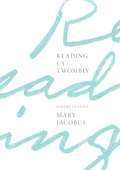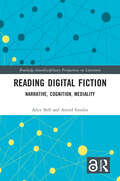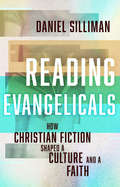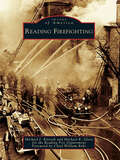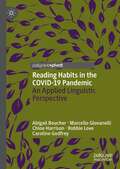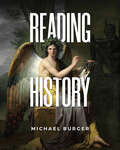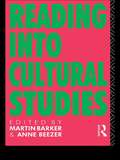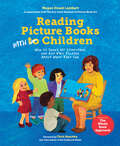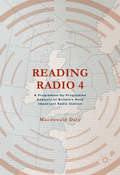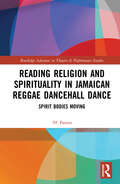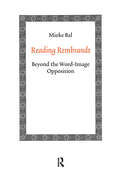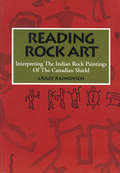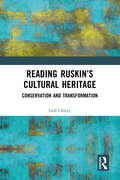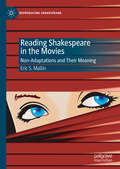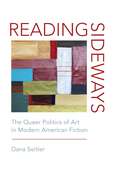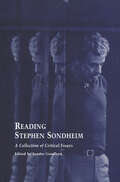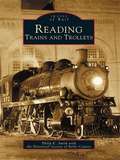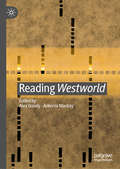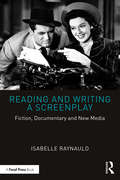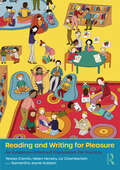- Table View
- List View
Reading Cy Twombly: Poetry in Paint
by Mary JacobusMany of Cy Twombly's paintings and drawings include handwritten words and phrases--naming or quoting poets ranging from Sappho, Homer, and Virgil to Mallarmé, Rilke, and Cavafy. Enigmatic and sometimes hard to decipher, these inscriptions are a distinctive feature of his work. Reading Cy Twombly poses both literary and art historical questions. How does poetic reference in largely abstract works affect their interpretation?Reading Cy Twombly is the first book to focus specifically on the artist's use of poetry. Twombly's library formed an extension of his studio and he sometimes painted with a book open in front of him. Drawing on original research in an archive that includes his paint-stained and annotated books, Mary Jacobus's account--richly illustrated with more than 125 color and black-and-white images--unlocks an important aspect of Twombly's practice.Jacobus shows that poetry was an indispensable source of reference throughout Twombly's career; as he said, he "never really separated painting and literature." Among much else, she explores the influence of Ezra Pound and Charles Olson; Twombly's fondness for Greek pastoral poetry and Virgil's Eclogues; the inspiration of the Iliad and Ovid's Metamorphoses; and Twombly's love of Keats and his collaboration with Octavio Paz.Twombly's art reveals both his distinctive relationship to poetry and his use of quotation to solve formal problems. A modern painter, he belongs in a critical tradition that goes back, by way of Roland Barthes, to Baudelaire. Reading Cy Twombly opens up fascinating new readings of some of the most important paintings and drawings of the twentieth century.
Reading Digital Fiction: Narrative, Cognition, Mediality (Routledge Interdisciplinary Perspectives on Literature)
by Astrid Ensslin Alice BellReading Digital Fiction offers the first comprehensive and systematic theoretical, methodological, and analytical examination of digital fiction from a cognitive and empirical perspective. Proposing the new concept of “medial reading”, it argues for the centrality of an audience’s interest in, awareness of and/or attention to the medium in which a text is produced and received, and which we argue should be applied to reader data across media. The book analyses and theorises five generations of digital fiction and their reading including hypertext fiction, hypermedia fiction, narrative video games, app fiction, and virtual reality. It showcases medium- and platform-specific methods of qualitative reader response research across a variety of contexts and settings from screen-based and embodied interaction to gallery installation, and from reading group and individual interview to think-aloud methodologies. The book thus addresses the unique affordances of digital fiction reading by designing and reporting on new empirical studies focusing on hypertextuality, interactivity, immersion, as well as medium-specific forms of textual “you”, ontological ambiguity, reader orientation and empathy. In so doing, the book refines, critiques, and expands cognitive, transmedial, and empirical narratology and stylistics by placing the reader of these new narratives front and centre.The Open Access version of this book, available at http://www.taylorfrancis.com, has been made available under a Creative Commons [Attribution-Non Commercial-No Derivatives (CC-BY-NC-ND)] 4.0 license.
Reading Evangelicals: How Christian Fiction Shaped a Culture and a Faith
by Daniel SillimanThe story of five best-selling novels beloved by evangelicals, the book industry they built, and the collective imagination they shaped Who are evangelicals? And what is evangelicalism? Those attempting to answer these questions usually speak in terms of political and theological stances. But those stances emerge from an evangelical world with its own institutions—institutions that shape imagination as much as they shape ideology. In this unique exploration of evangelical subculture, Daniel Silliman shows readers how Christian fiction, and the empire of Christian publishing and bookselling it helped build, is key to understanding the formation of evangelical identity. With a close look at five best-selling novels—Love Comes Softly, This Present Darkness, Left Behind, The Shunning, and The Shack—Silliman considers what it was in these books that held such appeal and what effect their widespread popularity had on the evangelical imagination. Reading Evangelicals ultimately makes the case that the worlds created in these novels reflected and shaped the world evangelicals saw themselves living in—one in which romantic love intertwines with divine love, humans play an active role in the cosmic contest between angels and demons, and the material world is infused with the literal workings of God and Satan. Silliman tells the story of how the Christian publishing industry marketed these ideas as much as they marketed books, and how, during the era of the Christian bookstore, this—every bit as much as politics or theology—became a locus of evangelical identity.
Reading Firefighting (Images of America)
by Michael R. Glore Michael J. Kitsock Chief William Rehr Reading Fire DepartmentFrom its inception in Colonial times to the modern challenges of today, the Reading Fire Department has battled natural disasters, airplane crashes, and block burners threatening "the Pretzel City." The fire department has faithfully served the city of Reading since 1771, having been established soon after Benjamin Franklin organized the nation's first volunteer fire department in Philadelphia. At one time the Reading Fire Department even boasted the largest all-volunteer fire department in the nation, consisting of more than 10,000 volunteer members operating from 14 fire stations throughout the city. Using the archives of the Reading Fire Department, the Reading Eagle, and the Historical Society of Berks County, Reading Firefighting documents the history and traditions of this dedicated fire department.
Reading Habits in the COVID-19 Pandemic: An Applied Linguistic Perspective
by Marcello Giovanelli Robbie Love Chloe Harrison Abigail Boucher Caroline GodfreyThis book presents and analyses the results of the Lockdown Library Project survey, using a range of quantitative and qualitative approaches to provide a unique insight into the ways in which the first UK COVID-19 lockdown affected public reading habits. The authors begin by outlining the background to the study, the research methodology and design, and an overview of the headlines of the data, before going on to survey the literature on the relationship between pandemics, literature (especially the role played by genre and popular fiction) and reading habits. They then examine how participants reported that the lockdown period had affected the amount that they read; how they accessed books and discussed their reading with others; the use of reading as a coping strategy; and returning to re-read books that offered familiarity, reliability, and nostalgia. Finally, the concluding chapter brings together the overall findings of the project and briefly outlines future work in the field. This book will be of interest to academics in fields such as literary and genre studies, applied linguistics, corpus linguistics, stylistics, health humanities, and sociology, as well as practitioners working in education, in bibliotherapy, and in libraries.
Reading History
by Michael BurgerHistory students read a lot. They read primary sources. They read specialized articles and monographs. They sometimes read popular histories. And they read textbooks. Yet students are beginners, and as beginners they need to learn the differences among various kinds of readings – their natures, their challenges, and the unique expectations one needs to bring to each of them. Reading History is a practical guide to help students read better. Uniquely designed with the author’s engaging explanations in the margins, the book describes primary sources across various genres, including documents of practice, treatises, and literary works, as well as secondary sources such as textbooks, articles, and monographs. An appendix contains tips and questions for reading primary or secondary sources. Full of practical advice and hands-on training that allows students to be successful, Reading History will cultivate a wider appreciation for the discipline of history.
Reading Hollywood: Spaces and Meanings in American Film (Short Cuts)
by Deborah ThomasThis book examines the treatment of space and narrative in a selection of classic films including My Darling Clementine, It's a Wonderful Life, and Vertigo. Deborah Thomas employs a variety of arguments in exploring the reading of space and its meaning in Hollywood cinema and film generally. Topics covered include the importance of space in defining genre (such as the necessity of an urban landscape for a gangster film to be a gangster film); the ambiguity of offscreen space and spectatorship (how an audience reads an unseen but inferred setting), and the use of spatially disruptive cinematic techniques such as flashback to construct meaning.
Reading Into Cultural Studies
by Martin Barker Anne Beezer"Reading Into Cultural Studies" revisits a selection of key texts central to the formation of cultural studies as a discipline and as a project. These texts address questions of power, ideology and the possibilities and limits of resistance. Each of the eleven essays in the collection renews an early study in one area of cultural investigation, bringing such seminal texts as "Subculture" by Dick Hebdige, "Loving With a Vengeance" by Tania Modleski and "Bond and Beyond" by Tony Bennett back to the centre of attention, However the essays are not purely celebratory. Each study is critically examined in a number of ways - for its research strategy, its implicit theories of power and ideology, for the empirical evidence it draws on and its conceptual framework. Together, the essays provide an introduction to some of the central debates and issues in cultural studies.
Reading Magic: Why Reading Aloud to Our Children Will Change Their Lives Forever
by Mem FoxWith passion and humor, Fox speaks of when, where, and why to read aloud and demonstrates how to read aloud to best effect and get the most out of a read-aloud session. She discusses the three secrets of reading, offers guidance on defining and choosing good books.
Reading Modern Drama
by Alan AckermanExploring the relationship between dramatic language and its theatrical aspects, Reading Modern Drama provides an accessible entry point for general readers and academics into the world of contemporary theatre scholarship. This collection promotes the use of diverse perspectives and critical methods to explore the common theme of language as well as the continued relevance of modern drama in our lives.Reading Modern Drama offers provocative close readings of both canonical and lesser-known plays, from Hedda Gabler to e.e. cummings' Him. Taken together, these essays enter into an ongoing, fruitful debate about the terms 'modern' and 'drama' and build a much-needed bridge between literary studies and performance studies.
Reading Modernity, Modernism and Religion Today: Spinoza and Van Gogh (Routledge Focus on Literature)
by Patrick GrantFeelings of rootlessness, fragmentation and loneliness are endemic in today’s secular societies. In the late nineteenth century, Émile Durkheim described this kind of social malaise as anomie, a concept this book locates within a historical narrative of the emergence of Modernism from Modernity. The book focuses on two representative figures, Benedictus de Spinoza and Vincent van Gogh, on whose works it offers significant new perspectives. Spinoza drew up a blueprint for Modernity, which is to say, the cultural transformations that took place as a result of the Scientific Revolution and the Protestant Reformation. In counterpoint to his overriding confidence in reason, a persistent current in Spinoza’s writing shows how concerned he was about a possible loss of confidence in his governing idea of a single Substance, the philosophical God, with which he sought to replace the creator God of the Bible. In promoting art as a means of filling the gap left by the absence of Spinoza’s philosophical God and the failures of traditional Christianity, Van Gogh also discovered the limitations of the vocation to which he had dedicated himself. He concluded that in the tension between art and anomie, a new kind of religious sensibility and understanding might emerge. This remains the case in the current postmodern cultural phase when fragmentation and incoherence are summoning up new assessments and re-configurations of values promoting new forms of solidarity, dialogue and religious understanding.
Reading Photographs: An Introduction to the Theory and Meaning of Images (Basics Creative Photography)
by Richard SalkeldReading Photographs is a clear and inspiring introduction to theories of representation and visual analysis and how they can be applied to photography. Introducing the development of photography and different approaches to reading images, the book looks at elements such as identity, gaze, psychoanalysis, voyeurism and aesthetics.Striking visual examples are used to illustrate the text and engaging case studies delve deeper into issues raised within each chapter, with brief activity points to allow the reader to apply relevant theories to their own practice.
Reading Picture Books with Children: How to Shake Up Storytime and Get Kids Talking about What They See
by Megan Dowd LambertA new, interactive approach to storytime, The Whole Book Approach was developed in conjunction with the Eric Carle Museum of Picture Book Art and expert author Megan Dowd Lambert's graduate work in children's literature at Simmons College, offering a practical guide for reshaping storytime and getting kids to think with their eyes. Traditional storytime often offers a passive experience for kids, but the Whole Book approach asks the youngest of readers to ponder all aspects of a picture book and to use their critical thinking skills. Using classic examples, Megan asks kids to think about why the trim size of Ludwig Bemelman's Madeline is so generous, or why the typeset in David Wiesner's Caldecott winner,The Three Pigs, appears to twist around the page, or why books like Chris Van Allsburg's The Polar Express and Eric Carle's The Very Hungry Caterpillar are printed landscape instead of portrait. The dynamic discussions that result from this shared reading style range from the profound to the hilarious and will inspire adults to make children's responses to text, art, and design an essential part of storytime.
Reading Radio 4
by Macdonald DalyThis book is a study of contemporary Radio 4 output, covering the entire broadcast day. Radio is largely neglected by media and cultural studies. The small body of existing work on Radio 4 is predominantly historical, focusing on institutional history, or sociological, focusing on contemporary BBC editorial and journalistic practices. Reading Radio 4, by contrast, analyses contemporary Radio 4 programmes entirely from the point of view of today's listener. Individual chapters correspond to all existing Radio 4 timeslots in the entire broadcast day of 19 hours 40 minutes, from 5. 20am to 1. 00am. The study, while academic in approach, aims to promote an informed and critical appreciation of Radio 4 for all listeners, as well as students of the media.
Reading Religion and Spirituality in Jamaican Reggae Dancehall Dance: Spirit Bodies Moving (Routledge Advances in Theatre & Performance Studies)
by 'H' PattenThis book explores the genealogy of Jamaican dancehall while questioning whether dancehall has a spiritual underscoring, foregrounding dance, and cultural expression. This study identifies the performance and performative (behavioural actions) that may be considered as representing spiritual ritual practices within the reggae/dancehall dance phenomenon. It does so by juxtaposing reggae/dancehall against Jamaican African/neo-African spiritual practices such as Jonkonnu masquerade, Revivalism and Kumina, alongside Christianity and post-modern holistic spiritual approaches. This book will be of great interest to students and scholars in performance studies, popular culture, music, theology, cultural studies, Jamaican/Caribbean culture, and dance specialists.
Reading Rembrandt: Beyond the Word-Image Opposition (Amsterdam Academic Archive)
by Mieke BalReading Rembrandt: Beyond the Word-Image Opposition explores the potential for an interdisciplinary methodology between visual art and literature. In a series of close analyses of works by Rembrandt, works as we see them today, through all the ways of seeing and commenting that precede, and texts related to those works, Mieke Bal questions the traditional boundaries between literary and visual analysis. Bal also studies Rembrandt's complex handling of gender and the representation of women in Rembrandt's painting. The methods used in this study come from both in- and outside the history of art. They demonstrate the author's sensitivity to the visual aspects of Rembrandt's work as meaningful. The works by Rembrandt gain in depth and interest, but an original perspective of the role of visuality in our culture also emerges, which ultimately has consequences for our views of gender, the artists, and the act of reading.
Reading Rock Art: Interpreting the Indian Rock Paintings of the Canadian Shield
by Grace Rajnovich Wayne YerxaMore than 400 rock paintings adorn the Canadian Shield from Quebec, across Ontario and as far west as Saskatchewan. The pictographs are the legacy of the Algonkian-speaking Cree and Ojibway, whose roots may extend to the beginnings of human occupancy in the region almost 10,000 years ago. Archaeologist Grace Rajnovich spent fourteen years of field research uncovering a multitude of clues as to the meanings of the paintings. She has written a text which is unique in its ability to "see" the paintings from a traditional native viewpoint. Skilfully weaving the imagery, metaphors and traditions of the Cree and Ojibway, the author has recaptured the poetry and wisdom of an ancient culture. Chief Willie Wilson of the Rainy River Band considers Grace’s work "innovative and original."
Reading Ruskin’s Cultural Heritage: Conservation and Transformation
by Gill ChittyJohn Ruskin's critical commentary on culture and society, transformative in his own time, established him as a leading critic of the 19th century. His prescient thinking resonates powerfully with today’s issues in cultural heritage conservation. This volume presents his ideas in context, key extracts from his works and future directions for his foundational ideas. Ruskin’s passionate responses to the environmental and social changes of his day chime with contemporary ideas on themes like sustainability, ethical production and environmentalism. Though widely recognised as a key figure in preservation history, his heritage work is rarely appreciated in full context and breadth. This volume presents six stimulating essays on Ruskin’s readership and reception, his transformative perceptions of heritage futures and provocative writing on cultural landscapes and the arts and crafts. Extracts from both well-known and lesser-known works accompany each chapter to reflect the distinctive vocality of his texts, from his writing on architecture and buildings, to landscape and cultural heritage. The volume offers a richer description of cultural context and meaning than usually afforded to Ruskin’s work in conservation and critical heritage studies finding its resonance and relevance. Written for an academic and professional audience in heritage studies and historic building conservation and particularly relevant for cultural heritage management, this is a core text and reference work for undergraduate and postgraduate students in history of art and architecture, heritage studies and architectural/building conservation, also central to interests of cultural historians and scholars of nineteenth-century/Victorian history and literature.
Reading Shakespeare in the Movies: Non-Adaptations and Their Meaning (Reproducing Shakespeare)
by Eric S. MallinReading Shakespeare in the Movies: Non-Adaptations and Their Meaning analyzes the unacknowledged, covert presence of Shakespearean themes, structures, characters, and symbolism in selected films. Writers and directors who forge an unconscious, unintentional connection to Shakespeare’s work create non-adaptations, cinema that is unexpectedly similar to certain Shakespeare plays while remaining independent as art. These films can illuminate core semantic issues in those plays in ways that direct adaptations cannot. Eric S. Mallin explores how Shakespeare illuminates these movies, analyzing the ways that The Godfather, Memento, Titanic, Birdman, and The Texas Chainsaw Massacre take on new life in dialogue with the famous playwright. In addition to challenging our ideas about adaptation, Mallin works to inspire new awareness of the meanings of Shakespearean stories in the contemporary world.
Reading Sideways: The Queer Politics of Art in Modern American Fiction
by Dana SeitlerReading Sideways explores the pivotal role that various art forms played in American literary fiction in direct relation to the politics of gender and sexuality in works of modern American literature. It tracks the crosswise circulation of aesthetic ideas in fiction and argues that at stake in the aesthetic turn of these works was not only the theorization of aesthetic experience but also an engagement with political arguments and debates about available modes of sociability and sexual expression. To track these engagements, its author, Dana Seitler, performs a method she calls “lateral reading,” a mode of interpretation that moves horizontally through various historical entanglements and across the fields of the arts to make sense of—and see in a new light—their connections, challenges, and productive frictions. Each chapter takes a different art form as its object: sculpture, portraiture, homecraft, and opera. These art forms appear in some of the major works of literature of the period central to negotiations of gender, race, and sexuality, including those by Henry James, Davis, Willa Cather, Du Bois, Sarah Orne Jewett, and Mary Wilkins Freeman. But the literary texts that each chapter of this book takes as its motivation not only include a specific art form or object as central to its politics, they also build an alternative aesthetic vocabulary through which they seek to alter, challenge, or participate in the making of social and sexual life. By cultivating a counter-aesthetics of the unfinished, the uncertain, the small, the low, and the allusive, these fictions recognize other ways of knowing and being than those oriented toward reductively gendered accounts of beauty, classed imperatives established by the norms of taste, or apolitical treatises of sexual disinterestedness. And within them—and through “reading sideways”—we can witness the coming-into-legibility of a set of diffuse practices that provide a pivot point for engaging the political methods of minoritized subjects at the turn of the twentieth century.
Reading Stephen Sondheim: A Collection of Critical Essays (Studies in Modern Drama #Vol. 10)
by Sandor GoodhartFirst Published in 2000. Routledge is an imprint of Taylor & Francis, an informa company.
Reading Trains and Trolleys
by Philip K. Smith Historical Society of Berks CountyRail transportation has been part of daily life in Reading since the 1830s. Reading Trains and Trolleys portrays the good old days of the Philadelphia & Reading Railway (reorganized as the Reading Company in 1923), the Schuykill Valley Division of the Pennsylvania Railroad, the Mount Penn Gravity Railroad, the Neversink Mountain Railroad, the Reading City Passenger Railway, and the Reading Traction Company. The Reading Railroad gained widespread recognition as a property for sale on the Monopoly board, but the history of trains and trolleys in Reading goes well beyond that iconography. Reading Trains and Trolleys documents the impact of railroad and trolley networks on Reading and adjoining communities, including photographs of the interior of the locomotive shop and the carbarn at Tenth and Exeter Streets, views of the Walnut Street yard before and after the Outer Station was constructed, and views from the Swinging Bridge, which spanned the yard by the Outer Station. The Historical Society of Berks County's collection of rail photographs includes many never-before-published images of diverse scenes in and around Reading.
Reading Westworld
by Alex Goody Antonia MackayReading Westworld is the first volume to explore the cultural, textual and theoretical significance of the hugely successful HBO TV series Westworld. The essays engage in a series of original enquiries into the central themes of the series including conceptions of the human and posthuman, American history, gaming, memory, surveillance, AI, feminism, imperialism, free will and contemporary capitalism. In its varied critical engagements with the genre, narratives and contexts of Westworld, this volume explores the show’s wider and deeper meanings and the questions it poses, as well considering how Westworld reflects on the ethical implications of artificial life and technological innovation for our own futurity. With critical essays that draw on the interdisciplinary strengths and productive intersections of media, cultural and literary studies, Reading Westworld seeks to respond to the show’s fundamental question; “Have you ever questioned the nature of your reality?” It will be of interest to students, academics and general readers seeking to engage with Westworld and the far-reaching questions it poses about our current engagements with technology.
Reading and Writing a Screenplay: Fiction, Documentary and New Media
by Isabelle RaynauldReading and Writing a Screenplay takes you on a journey through the many possible ways of writing, reading and imagining fiction and documentary projects for cinema, television and new media. It explores the critical role of a script as a document to be written and read with both future readers and the future film it will be giving life to in mind. The book explores the screenplay and the screenwriting process by approaching the film script in three different ways: how it is written, how it is read and how it can be rewritten. Combining contemporary screenwriting practices with historical and academic context, Isabelle Raynauld provides key analytical tools and reading strategies for conceptualizing and scripting projects based on the impact different writing styles can have on readers, with various examples ranging from early cinema to new media and new platforms throughout. This title offers an alternative, thought-provoking and inspiring approach to reading and writing a screenplay that is ideal for directors, producers, actors, students, aspiring screenwriters and readers interested in understanding how an effective screenplay is created.
Reading and Writing for Pleasure: An Evidence-Informed Framework for Practice
by Teresa Cremin Liz Chamberlain Helen Hendry Samantha Jayne HulstonReading and writing for pleasure represent issues of global concern and interest in policy, research and practice, underpinned by evidence illustrating their importance for young people’s academic, social and emotional experiences and outcomes. In the face of a sustained decline in children’s enjoyment in both reading and writing, this highly significant book presents findings from a three-year study of research and practice that nurtures young people’s engagement as readers and writers.The book offers a rich understanding of the study, highlighting the commonalities and synergies identified from the research literature and diverse practice contexts. It introduces a new and powerful Reading and Writing Framework for Practice for schools and charitable literacy programmes. The authors offer practical strategies and recommendations throughout for practitioners, researchers and policy makers who wish to advance this agenda in their own contexts. Areas covered include: The nature of reading and writing for pleasure Literate identities Motivating readers and writers Social interactions Role models and connected communities Future research, practice and policy This field-defining text is a key resource for all those committed to halting the decline in young people’s engagement as volitional readers and writers.
